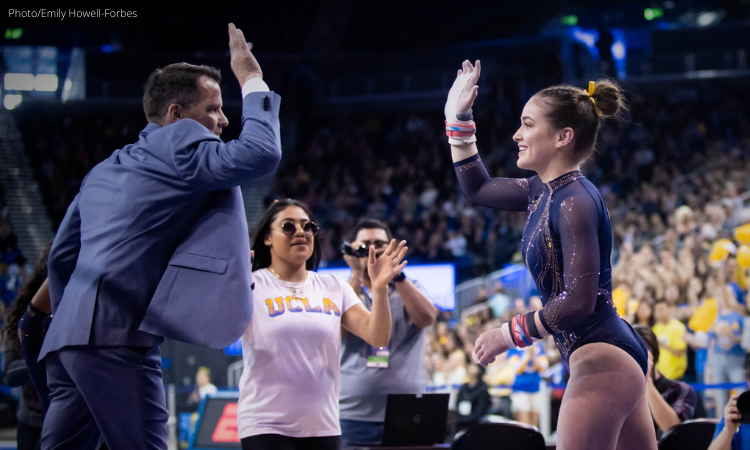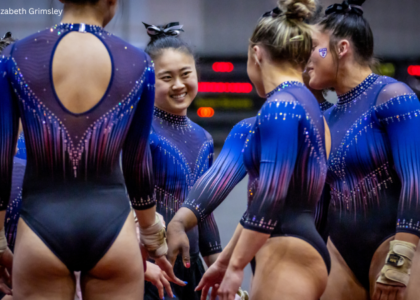Now that the June 15 date has passed and gymnasts in the class of 2023 can start verbally committing to college, it seems the appropriate time for a brief refresher on the basics of college gymnastics recruiting.
The first thing to know is that recruiting can take years of relationship-building and perseverance. It starts before the gymnast is allowed to commit to college, goes through a long recruiting process and ends with the signing of a National Letter of Intent. Let’s go through each step.
Verbal Commitments
At the end of their sophomore year of high school, gymnasts can start being recruited by college teams. Recruiting happens when a college coach shows interest in a student-athlete doing gymnastics for their university.
The recruiting process takes several steps.
First, there is the initial contact between gymnasts and college coaches. Contact happens every time a coach says more than hello to an athlete in an in-person meeting and can take multiple forms: face-to-face encounters, phone calls and email correspondence, and exchange of material through email or social media.
Once contact has been established, college coaches often attend meets or travel to the gymnast’s gym to see the athlete train and compete. This is called evaluation.
The athlete is also encouraged to go on unofficial college visits to get a feel of the campus and the college life she will join. Unofficial visits are paid for by the gymnast or their parents and typically occur before a gymnast is officially committed. They differ from official visits, which are paid for by the university and occur once the athlete is college-bound.
Gymnasts can start going on college visits in August following the opening of the verbal period in June. Given the two-month hiatus, athletes are advised to wait to verbal until they are able to step foot on campus.
If contact between the gymnast and the coaches is positive and satisfying on both sides, the athlete can make a verbal commitment, which occurs when the gymnast verbally agrees to do gymnastics for a college before she signs her National Letter of Intent. The commitment is not binding on either the school’s or the athlete’s part, and can be rescinded at any time.
Academic Criteria
Doing gymnastics in college is not just about sports—it’s also about school. To be eligible to compete in college during her freshman year, the gymnast is required to meet certain academic requirements.
To be eligible to compete for a Division I team, gymnasts need: 1) to have completed 16 core courses, including four years of English, three years of math, two years of natural/physical science, one additional year of English, math or natural/physical science, two years of social science and four additional years of English, math, natural/physical science, social science, foreign language, comparative religion or philosophy; 2) to have completed 10 core courses before their seventh semester; 3) to have earned at least a 2.3 GPA in their core courses; 4) to have earned an SAT combined score or ACT sum score matching the core-course GPA on the Division I sliding scale. Note that test scores will not be required for student-athletes enrolling for the 2022-23 season.
To be eligible to compete for a Division II team, criteria are similar but a bit lower. Gymnasts do not need to have completed 10 core courses before their seventh semester and have to earn a 2.2 GPA in their core courses.
Academic requirements may also vary according to the college.
National Letter of Intent
If the athletic and academic requirements are met, gymnasts in their senior year of high school can sign their National Letter of Intent during the signing period. By signing the NLI, the athlete agrees to attend a Division I college for one year and will receive financial aid for that first academic year.
Once the letter is signed, the recruiting process ends and the gymnast cannot be recruited by other colleges. If she wishes to change her commitment, she has to request a release from her contract with the university.
Division III colleges do not have a National Letter of Intent but can use an NCAA-approved celebratory signing form. The same goes for Ivy League schools and service academies, which do not offer athletic scholarships.
The initial week for National Letter of Intent signing is usually in early November and extends to August 1. The 2021 signing period will start on November 10.
Scholarships
Athletic scholarships are extremely competitive—the NCAA has calculated that only 2% of high school athletes are awarded athletic scholarships to compete in college.
The chances of being awarded an athletic scholarship are slim because the number of talented athletes bypasses by far the number of available scholarships, which is limited for each school. Division I schools have 12, Division II schools have six and Division III colleges don’t award athletic scholarships, though other forms of financial aid are often available. While Division I schools can only offer full scholarships, Division II scholarships can be divided among multiple athletes.
Given the difficulty of achieving an athletic scholarship, gymnasts shouldn’t feel discouraged if they are not awarded one. It’s not necessarily indicative of their gymnastics abilities. If money is an issue, athletes can find alternative ways of getting financial aid, such as through in-state tuition or academic scholarships.
Too Young to Verbal?
Gymnasts who haven’t completed their sophomore year of high school cannot have any contact with colleges, but they can still work toward their recruiting process and make themselves known by college coaches.
The first step is to target the right schools based on the athletes’ gymnastics and academic abilities, as well as social and personal preferences. The second step is for gymnasts to curate their social media platforms. It is important for them to upload training and competition videos regularly. Finally, although athletes cannot have direct contact with college coaches, they can start sending them emails introducing themselves and presenting them with their gymnastics videos and other pertinent information.
Once a gymnast is in high school, it’s never too early to start planning her recruiting process. It’s crucial for the athlete to take her time to fulfil every step, make her decisions and especially not miss any important deadlines.
READ THIS NEXT: Biggest Movers and Improvers in the Class of 2022 Recruit Ratings
Article by Talitha Ilacqua
Like what you see? Consider donating to support our efforts throughout the year!



